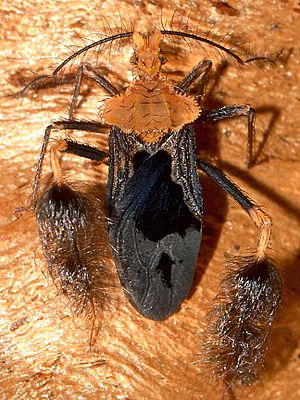Ptilocnemus lemur facts for kids
Quick facts for kids Ptilocnemus lemur |
|
|---|---|
 |
|
| Scientific classification | |
| Kingdom: | |
| Phylum: | |
| Class: | |
| Order: | |
| Family: | |
| Subfamily: |
Holoptilinae
|
| Tribe: |
Holoptilini
|
| Genus: |
Ptilocnemus
|
| Species: |
P. lemur
|
| Binomial name | |
| Ptilocnemus lemur (Westwood, 1840)
|
|
The Ptilocnemus lemur is a fascinating insect often called the feather-legged assassin bug. It belongs to the assassin bug family and lives in Australia. This bug is a skilled hunter that specializes in catching ants. It has a special gland called a trichome. This gland helps it attract and paralyze ants before it eats them.
What it Looks Like
The Ptilocnemus lemur is a medium-sized assassin bug. It has a small head with two feathery antennae. These antennae have three parts. It also has a large, curved mouthpart called a proboscis. Its body has a wide middle section (thorax) and a fairly broad back section (abdomen).
Its wings have three clear veins. The two back legs are much bigger than the front and middle ones. These back legs are covered in many stiff hairs, like bristles. The bug's head and thorax are yellowish-brown. Its abdomen has a mix of grey and black colors, making it look mottled.
Where it Lives
The P. lemur bug is found only in Australia. It lives in forests, often on the trunks of trees. Its dull colors help it camouflage itself. This means it blends in perfectly with the tree bark, making it hard for other animals to spot it.
How it Hunts
This assassin bug has a special secret weapon called a trichome. This is a gland located on the underside of its third abdomen segment. The trichome makes a special liquid that attracts ants. This liquid also paralyzes them. There are also other glands on the front parts of its abdomen. Young bugs, called nymphs, have these other glands too, but not the trichome.
Both adult bugs and nymphs are expert ant hunters. Scientists have studied how the nymphs hunt very closely. A nymph will stand near an ant trail. It waves one of its hairy back legs to get the attention of a passing ant. It often targets the jack jumper ant (Myrmecia pilosula). Sometimes, the ant can be bigger than the nymph itself! The bug also releases a special scent, called a pheromone, to draw the ant closer.
When an ant gets near, the nymph lifts its body up. This lets the ant touch and taste the special liquid from the trichome. The bug waits for the ant to grab its hind leg. Then, the bug quickly turns around. It plunges its sharp mouthparts, called stylets, into a soft spot on the ant. This spot is usually the joint at the back of the ant's head.
The bug then shakes the ant around. This might stop the ant from biting back. It also injects saliva into the wound. The ant quickly becomes paralyzed and dies. The bug might carry the ant to a hidden spot, like a crack in the tree bark. Once the ant's insides turn into liquid, the bug sucks out all the fluids.

